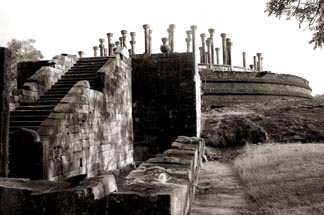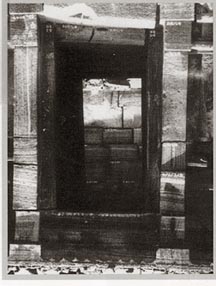|
observer |
|
|
|
|
|
OTHER LINKS |

|

|

|
The glory left behind
Polonnaruwa came into existence in 1017, when the Cholas who descended from South India captured power from King Mahinda who was in Anuradhapura, which was this island's capital at the time. The visibility of many Hindu shrines in this ancient city, both within the archaeological boundaries and the contemporary towns that surround it, sitting side by side with the vast number of Buddhist monuments and other places of religious worship, resulted from the Chola invasion. They reflect the importance the invaders placed in propagating Hinduism here. At the beginning of the 11th century, Polonnaruwa thrived as a successful hub with a lot of political activity under the rule of the Cholas. They subsequently transformed it into a beaming royal city. Though the city bloomed to look as it was enclosed by total Hinduism the destiny of the city changed drastically under the rule of Vijayabahu I. He ruled the royal city for nearly 50 years after capturing power from the Cholas. With the end of Vijayabahu's rule in 1110 AD, a number of kings ruled Polonnaruwa until, in 1153, a noble king emerged who was hailed as a hero among the Singhalese. This was Parakramabahu I who reigned for 33 years. It was unmistakably the golden era for a city that was threatened by many foreign rulers during its existence. It became a focal city of a medieval past. Parakramabahu I was a builder and that is exactly what his reign was all about. The many tanks and gardens that he built were of wide service to this country as history proves. The Parakramabahu Samudraya (inland sea) that we see as an impressive historical creation is one such gigantic work by him. The seven-storey Vaijayanta Prasada, Galviharaya, and the many monasteries stand evident of the development work that King Parakramabahu carried out during this tenure." Kirti Sri Nissankamalla followed as the next king to rule the royal city. A total believer in Buddhism and its philosophy, the arrogant ruler always maintained the fact that no foreign ruler from neighbouring India should be allowed to set foot on our shores. His demise after many years of rule created instability within the state. Most of the statues of Hindu deities like Lord Ganesh, Parvathi, Vishnu, Siva Nataraja, etc., that are sitting at the Cultural Triangle museum were found during the excavations done within the Polonnaruwa archaeological site.
Lankatileke Vihare and the Vatadage are two monuments that prove that there was strong Buddhist representations, and the Bikkhus played a pivotal role in the ruling of this country. Vijayanta Prasada, the royal palace of Parakramabahu I has three stories intact but it is said to have had seven storeys with a thousand chambers. The Siva Devale, which is at the left to the entrance of the ancient city, is built in Chola style. Executed completely in stone, the shrine has many sculptures of a variety of Hindu gods and goddesses. Four rows of symmetrically placed stone pillars with the lion throne placed at the far end, form the Council Chamber used by King Nissankamalla and his council of ministers. It is a magnificent structure that still delights visitors to this architectural site. Today Polonnaruwa stands as evidence of a past that was sometimes glorious, and to a state that was volatile during most of its rule both by local and Indian kings. It was a kingdom acquired through many battles fought by those who wanted Polonnaruwa to be under their purview at one time or another. It was a jewel that many rulers set their greedy eyes upon. They grabbed it at the first opportunity they smelt a weak ruler seated on the throne. Incidents of such nature seemed to have been common when one scrutinises the past, set against the royal abode that sits in monumental ruins today. The Polonnaruwa historical and archaeological site, however, has never ceased to be a mirror that reflects our past and offers vital clues to our civilisation and cultural heritages. The cultural triangle, on the other hand, has had a large amount of excavation work done to unearth many artifacts and evidence, which has been reinstated at the new museum. As one walks through the cultural triangle museum one travels through time, which holds many memories of a regal past that Sri Lanka was hundreds of years ago. |












